
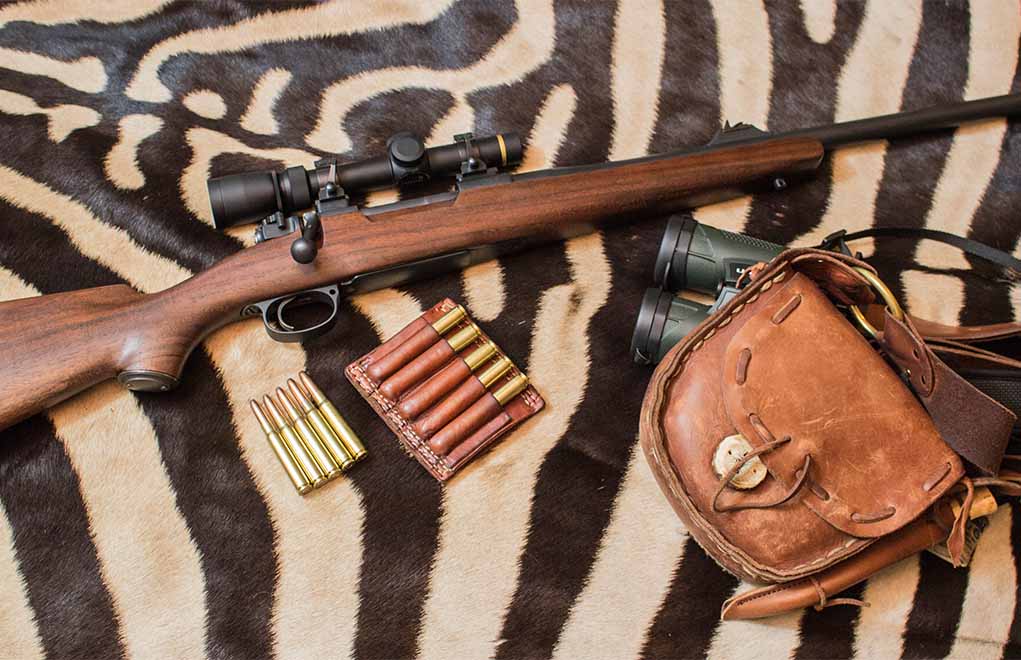
A genesis in the golden age of African safaris, the .318 Westley Richards Accelerated Express is all but a historical footnote. Though the odd specimen still proves potent.
What The .318 Westley Richards Offers Hunters:
- Came on the scene somewhere between 1908 and 1910.
- Generally offered in light rifles.
- Shot a bullet with .330-inch diameter in the neighborhood of 2,400 and 2,700 fps.
- Became known for its exceptional penetration.
I’ve long been an aficionado of the “golden age” of African safaris, including its literature—and especially its rifles and cartridges. Those years when safaris really got going—from 1900 to 1914, and then again from 1919 to 1940—saw a parallel era of cartridge development, with some of the newly introduced designs going on to become undeniable classics … and others fading into obscurity.
The .375 Holland & Holland, .416 Rigby, .404 Jeffery, .333 Jeffery, .275 Holland & Holland and the .470 Nitro Express were all released before the outbreak of the Great War, and while some are household names, others have long become unavailable or remain a rarity at best. Among those is a simple, little cartridge that kept popping up in those classic books, as well as in my research on the famous hunters of the era—the .318 Westley Richards (WR) Accelerated Express.
The Remarkable .318 WR Accelerated Express
It doesn’t have a ton of case capacity or a truly heavy bullet, but it does possess a quality that was extremely desirable: It gave excellent penetration. The .318 WR came onto the scene between 1908 and 1910—before the .375 H&H made its debut—and it was touted as an all-around cartridge for both Africa and India, even for elephant.
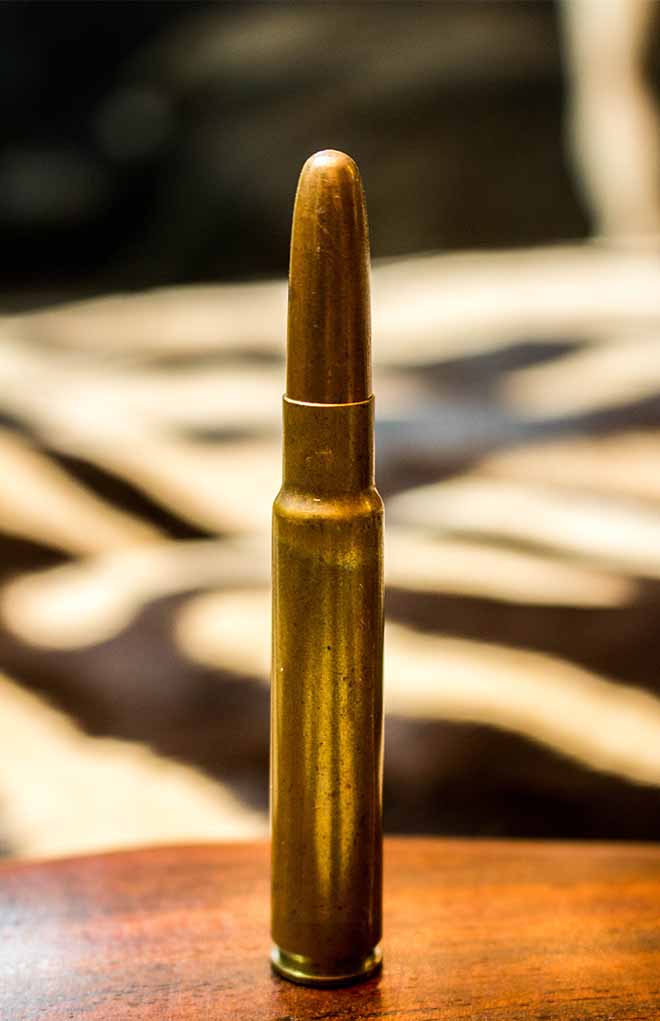
The cartridge came in a light, handy rifle, and it was offered with two loads: the 250-grain softpoint full-patch or solid at 2,400 fps, and a 180-grain LT-capped bullet (“LT” were the initials of Leslie Taylor, one of Westley Richards’ engineers) at 2,700 fps, although the lighter load never really caught on. The .318 WR uses a bullet of .330-inch diameter and, at 250 grains, it offers a sectional density of .328. That’s a big part of the famous penetration.
John “Pondoro” Taylor wrote in his famous book, African Rifles and Cartridges, of the .318 WR: “It has quite remarkably deep penetration, fully capable of driving its bullet the length of a big elephant’s body.”
Taking the context of his statement, we can confidently assume that he was writing of the solid bullet. Many hunters of the era (including Major G.H. “Andy” Anderson, Captain Jimmy Sutherland, Quentin Grogan [whose brother walked from Capetown to Cairo] and W.D.M. “Karamojo” Bell) relied on the .318 WR for hunting in more-open country.
From Dream to Reality
But, history is history. The .318 Westley Richards faded away, and the .375 Holland & Holland belted magnum went on to become the darling of the safari community. However, the cartridge stuck in my craw, and I remember reading about Craig Boddington’s exploits shooting bush pigs with a .318 WR he found in a remote gun shop.

That just sealed the deal. I scoured the Internet, looking for a true Westley Richards rifle I could afford. However, that was not in the cards.
Nevertheless, I did happen to have a 1916 Amberg Arsenal Gew. 98 Mauser in my possession, and while the serial numbers matched on each part of the rifle, the barrel was far beyond saving. I contacted my buddy, Nathan Chesney, at Hillbilly Rifles of Newport, Vermont, and he agreed to build my .318 WR. The dream was going to come true.
More Rifle Articles:
- A Different .22: Savage B Series Hardwood
- Does The .357 Rifle Reign Supreme?
- Kimber’s Advanced Tactical Line Continues To Hit The Mark
- If You Had To Pick Just One Cartridge, What Would It Be?
- Aussie-Style Accuracy With The Lithgow LA102
Chesney and I ordered a Kreiger barrel, a three-position wing safety to allow for a low scope mount, Timney trigger, NECG barrel band front sight, Talley rings and bases, and a Leupold VX-3i 1.5-5x scope. For a stock, Chesney found a cool sporter stock from the late 1950s or early ’60s that showed some promise. We retained the action, trigger guard, magazine and bottom metal from the Gew. 98; and, on my shoestring budget, Chesney did a heck of a job transforming the century-old military rifle into a working .318 Westley Richards.
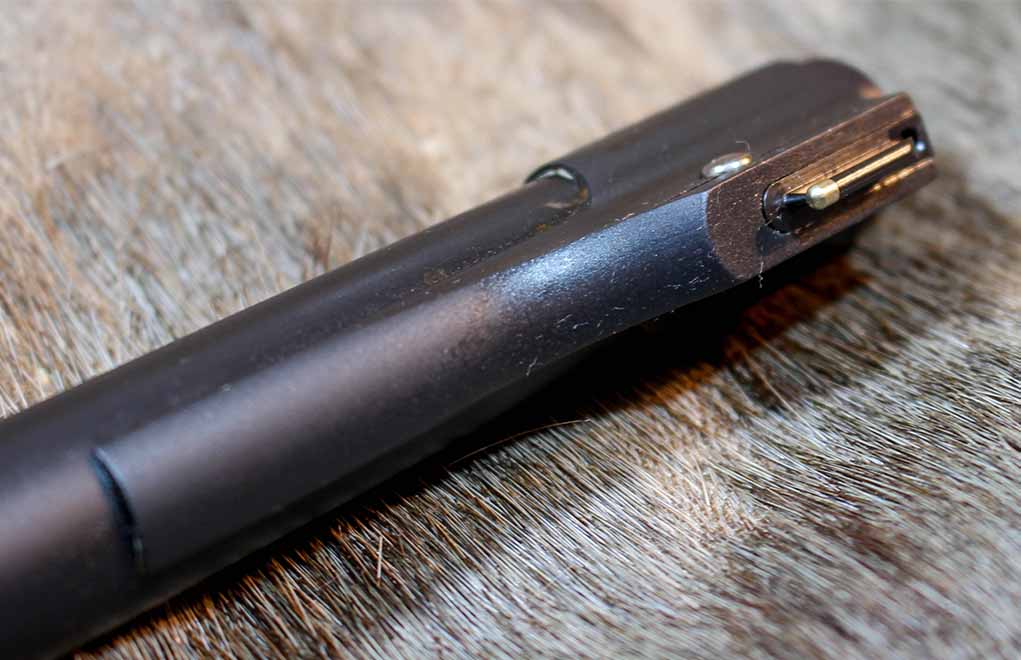
For brass, I procured a set of RCBS dies for the .318 WR and cut down some .30-06 Springfield cases. One pass through the resizing die and a bit of trimming, and I was in business. The first trip to the range turned out to be a real eye-opener: With a 250-grain Woodleigh Weldcore and a healthy charge of Reloder-16, we had MOA accuracy and 2,475 fps of muzzle velocity.
I took the rifle out that fall and managed to fill a doe tag. I was grinning ear to ear, because I’d fulfilled my dream of using a .318 Westley in the field.
But, things were about to get much better. I was at the Dallas Safari Club convention, sharing a beer with none other than PH Brian van Blerk, when we “made a plan,” as the Africans love to say: We’d be hunting the Chirisa block of Zimbabwe for buffalo (my Heym .470 NE double would handle that), as well as ancillary plains game. The .318 WR and I would be hunting wild Africa together.
Brass, Bullets and Loads
The Woodleigh Weldcore is not the only bullet available for the .318 Westley Richards. There are some boutique bullet companies, such as Hawk Bullets, that will make a run of .330-inch bullets now and again. Hornady makes a 205-grain bullet of this caliber for the 8x56R InterLock spitzer that makes a perfect choice for deer and similarly sized game. But I also found that Peregrine Bullets (in South Africa) makes 200- and 225-grain versions of its excellent VRG-3 BushMaster—the mono-metal hollow-point with the flat, brass plunger at the meplat. Both of these bullets shot very well in my rifle.
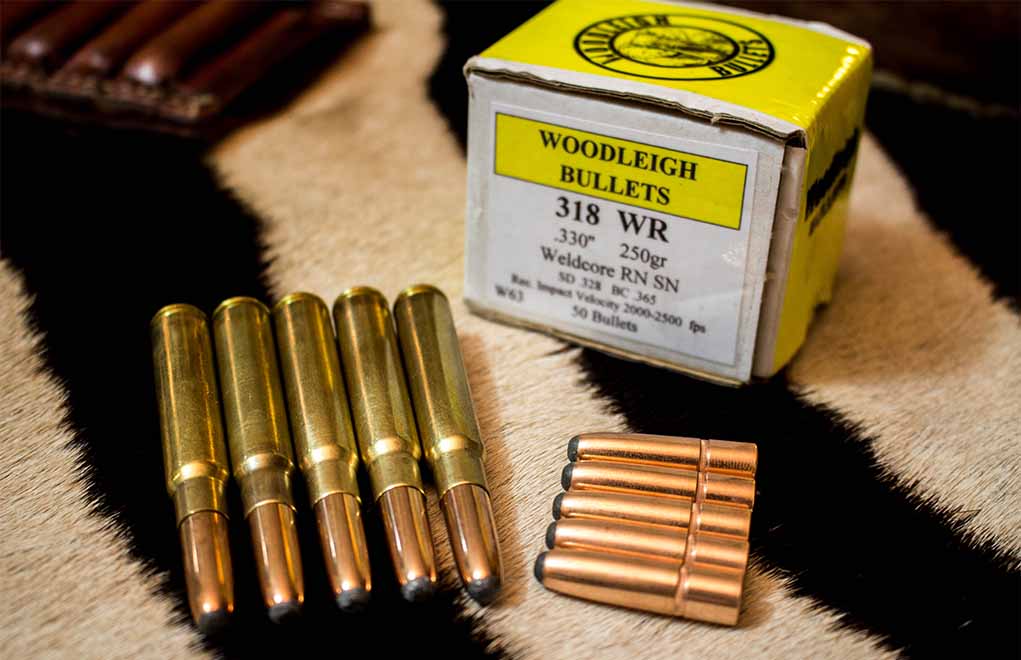
For cases, my own trimmed-down .30-06 cases gave very uniform and accurate results (the Reloder 16 load gives an extreme spread of 8 fps), but there’s one little nagging point regarding those cases: Most African countries require that the headstamp on the ammunition matches the rifle. Bertram Brass from Australia is one of the few sources of properly headstamped cases, and while its .318 WR stuff works, it hasn’t been the most consistent.
However, I stumbled across a new company right here in the States that can, and will, make any cartridge case you want. Roberson Cartridge Company (RCC), headed by Jeff Roberson, uses a CNC lathe to turn each case, resulting in a very uniform and consistent product with a different molecular structure than drawn cases possess. I’m happy to report that its .318 WR cases are no exception, and RCC cases have become a favorite of mine.
The Go-To Westley Richards Load
The Reloder 16 and 250-grain Woodleigh load is, most definitely, my go-to load for the .318 WR, because it’s the formula that made the cartridge so popular among hunters a century ago. But the other designs, such as the Peregrine BushMaster and the lighter Hornady, are most certainly going to be put to work.
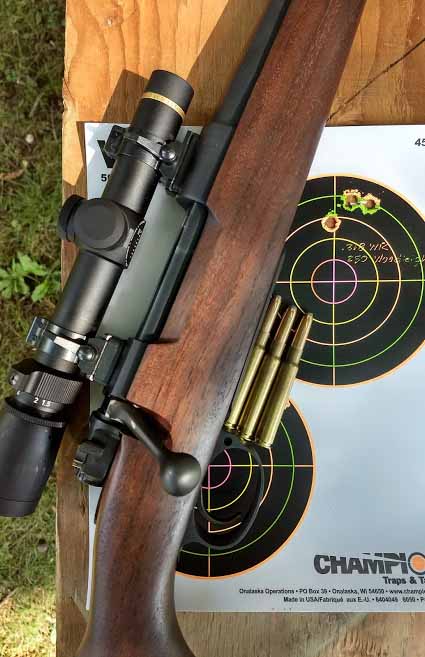
There’s some good data for the .318 WR in the Woodleigh Bullets reloading manual, but only for the 250-grain bullet. My own load is not in there (RL-16 wasn’t available at the time it was printed), but I used Woodleigh’s data to develop a load for my buddy, Mike McNulty, who owns a sweet 1952 Coswell & Harrison .318 WR that loves the 250-grain Woodleigh over H4831SC. I have developed a few loads for the lighter bullets using RL-16 and IMR4166; all of them have proved safe to fire in my rifle. They give very uniform velocities and are much less sensitive to temperature swings than other powders, which is perfect for the wide range of environments in which this rifle is used.
The .318 WR in the Field
In the Chirisa block of Zimbabwe, Brian van Blerk and the staff of Sitatunga Zimbabwe greeted us after our 33-hour journey. After one of the best nights of sleep I’ve ever had, we headed to the range to confirm zero on the rifles.
Brian and PH Adam Goosen, who was hunting with Mike McNulty, were both intrigued with the pair of .318 WRs; they’d never seen one on safari before. Our primary goal was buffalo, but there were plains game species on quota that we were both after. The arrangement was for each of us to carry our heavy rifles (that Heym .470 double for me and a Heym .505 Gibbs for Mike), while our respective trackers would carry the .318 WRs in case we encountered one of the target plains game species.
As it turns out, Mike had a great safari, and he took a good buffalo bull and an ancient bushbuck ram; but all were taken with his .505 Gibbs. I, on the other hand, had a couple of opportunities to put the .318 WR to the test.
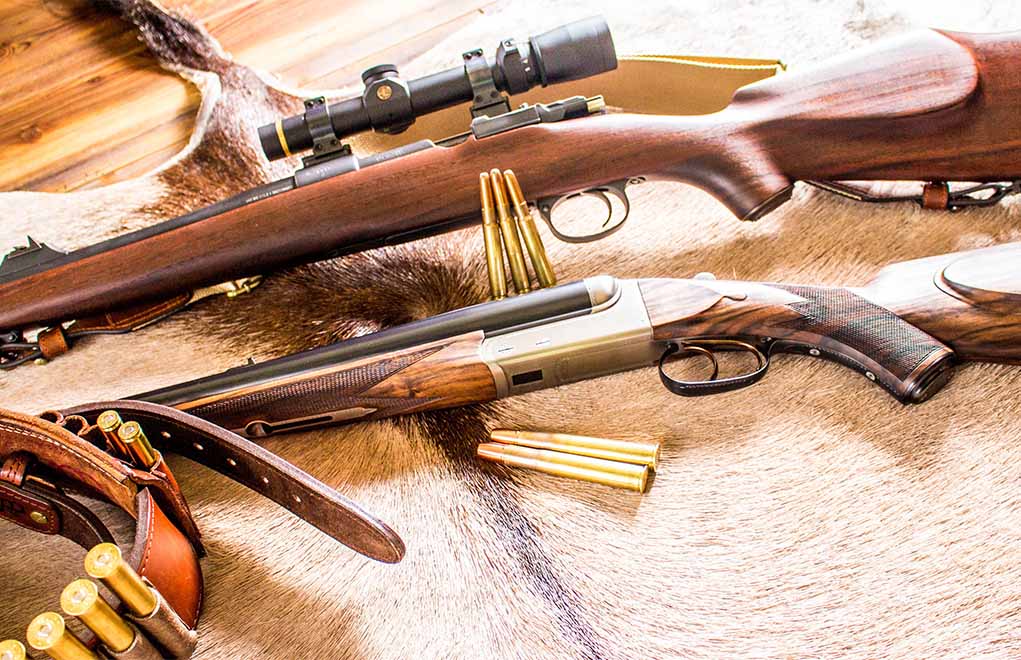
The wind had ruined our stalk on a buffalo herd. As we made the long trek back to the cruiser, Albert Ndlovu, Brian’s head tracker, stopped and pointed.
“Punda,” he said, using the Kiswahili word for zebra (although Brian and Albert are both native Zimbabweans, they spent years hunting in Tanzania). “Dume mbili, Bwana, punda m’zuri.” There were two stallions, both good specimens.
We began the hunched-over stalk toward the pair. The zebra were feeding gently at about 80 yards, so we had just enough brush between us to prevent taking the shot. What was probably only five minutes seemed like an eternity. Finally, the darker of the two stallions turned broadside, and the .318’s trigger broke. Even through the muzzle blast and the recoil, I heard the bullet hit. The zebra whirled and dropped within 15 yards.
The Woodleigh had completely penetrated both shoulders, taking out the heart on the way. With a jet-black stripe down the middle of his back and a very attractive hide, the zebra made an excellent trophy … and even better table fare. Yes, you read that correctly: Zebra are delicious.
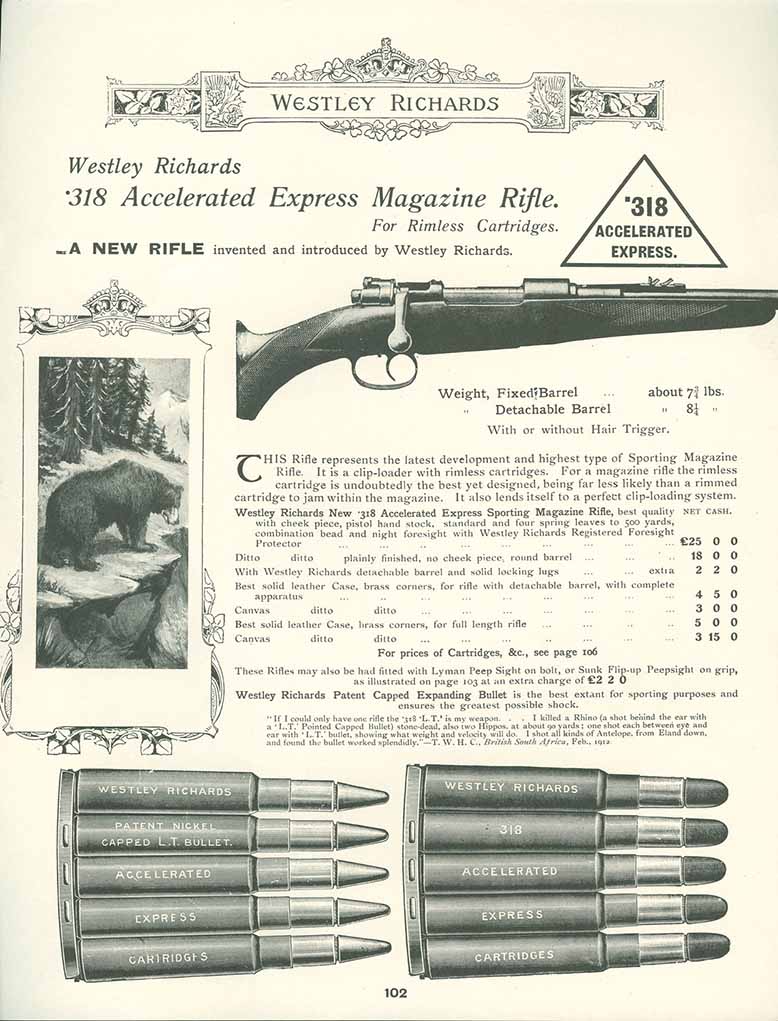
The second opportunity came at midday a couple of days later. Temperatures had risen to 114 degrees, and we had given up on the buffalo for the morning. We were headed back to camp for lunch and a siesta when the trackers and Brian became immediately excited, and the truck stopped.
“Did you see the kudu?”
Brian, in less-than-tender words, instructed me to grab the .318 and follow him. Not being one to argue with a man whose advice I was paying for, I did just that.
The stalk was short, but the shot presented was not optimal, because the bull was facing straight away.
“Texas heart shot. Do it now.”
The bull jumped at the shot and ran down into the korongo.
“The shot felt good, Brian,” I reported.
“You hit him hard. Let’s just give him a minute, and the trackers will pick up his spoor.”
The tracking job wasn’t a long one; a handsome kudu bull with 55-inch horns and the scars of a lifetime of fighting for breeding rights lay on his side within 40 yards.
Upon autopsy, the Woodleigh was found against the inside of the breast bone, having penetrated nearly the entire animal. That’s the penetrative quality of the .318 Westley Richards, especially with the high-sectional-density bullets.
I’ve been passionately working to bring the .318 WR back from the grave. In addition, there’s a small movement abroad as a result of guys building rifles and loading ammo to feed the vintage rifles on the market.
The .318 Westley Richards remains an obscure cartridge, but if I have my way, it will see its way back into the hands of hunters in a modern production rifle … with reliable factory ammunition.
Editor's Note: This article originally appeared in the September 2019 issue of Gun Digest the Magazine.
Purchase The Components Used In This Article:
- RCBS Dies starting at $38.99 at Cabela's
- Woodleigh Weldcore bullets
- Reloader 16 $31.99 at Sportsman's Warehouse
- Hawk Bullets
- Hornady InterLock Bullets starting at $27.99 at Cabela's
- Peregrine BushMaster Bullets
- RCC Brass
- Hodgdon H4831SC Powder $34.99 at Sportsman's Warehouse
- IMR 4166 Powder $29.99 at Brownells

Next Step: Get your FREE Printable Target Pack
Enhance your shooting precision with our 62 MOA Targets, perfect for rifles and handguns. Crafted in collaboration with Storm Tactical for accuracy and versatility.
Subscribe to the Gun Digest email newsletter and get your downloadable target pack sent straight to your inbox. Stay updated with the latest firearms info in the industry.

![Best Concealed Carry Guns In 2025 [Field Tested] Wilson Combat EDC X9S 1](https://gundigest.com/wp-content/uploads/Wilson-Combat-EDC-X9S-1-324x160.jpg)


![Best 9mm Carbine: Affordable PCCs [Tested] Ruger Carbine Shooting](https://gundigest.com/wp-content/uploads/Ruger-Carbine-Shooting-100x70.jpg)
![Best AR-15: Top Options Available Today [Field Tested] Harrington and Richardson PSA XM177E2 feature](https://gundigest.com/wp-content/uploads/Harrington-and-Richardson-PSA-XM177E2-feature-100x70.jpg)
